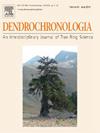地下森林:通过从Dippoldiswalde中世纪银矿中发现的木材,追溯Erzgebirge的森林历史
IF 2.3
3区 农林科学
Q1 FORESTRY
引用次数: 0
摘要
中世纪的淘金热深刻地影响了欧洲矿区的景观和植被,2009年在Dippoldiswalde (Erzgebirge东部/萨克森州)发现的保存异常完好的银矿就是一个很好的例证。这项研究分析了在这些矿山中收集的2000多个木制发现,其中包括1183个样本,这些样本利用树木年代学技术帮助确定了从12世纪下半叶到13世纪晚期的采矿活动。我们广泛的树木数据集为探索景观和气候变化、采矿对原始森林的影响以及采矿过程中木材的选择性使用等各个方面提供了宝贵的资源。这些木材不仅揭示了以前未知的采矿技术,而且还揭示了原始森林和早期森林利用的新见解。最初,矿工们没有选择性地开采森林。因此,早期木材的使用为了解曾经覆盖该地区的原始Fagus-Abies森林的组成提供了重要的见解。到了12世纪,木材的广泛使用开始出现,最终导致了中世纪额尔齐布尔格矿区的大面积森林被完全砍伐。这项研究强调了在推进环境历史和中世纪采矿领域的研究方面,对所有可用的考古木材进行年代学测年的宝贵潜力,而不仅仅是选定的样本。本文章由计算机程序翻译,如有差异,请以英文原文为准。
The underground forest: Tracing forest history in the Erzgebirge through the wood finds from the medieval silver mines of Dippoldiswalde
The medieval silver rush profoundly impacted the landscape and vegetation of Europe’s mining regions, a phenomenon strikingly illustrated by the exceptionally well-preserved silver mines discovered in Dippoldiswalde (Eastern Erzgebirge/Saxony) in 2009. This study analyses over 2000 wooden finds collected in those mines, including 1183 specimens that help date the mining activities from the second half of the 12th century to the late 13th century, utilising dendrochronological techniques. Our extensive dendro-dataset provides a valuable resource for exploring various aspects, such as landscape and climatic change, the effects of mining on primary forests, and the selective use of wood in mining processes. The timber reveals new insights not only into previously unknown mining technologies but also into the primeval forest and early forest use.
Initially, miners exploited the forest non-selectively. As a result, early timber use provides important insights into the composition of primeval Fagus-Abies forests that once covered the region. By the 12th century, extensive timber use began to emerge, eventually leading to the complete deforestation of large areas in the mining regions of the Erzgebirge in the Middle Ages. This study underscores the valuable potential of dendrochronologically dating all available archaeological wood, rather than just selected samples, for advancing research in the fields of environmental history and medieval mining.
求助全文
通过发布文献求助,成功后即可免费获取论文全文。
去求助
来源期刊

Dendrochronologia
FORESTRY-GEOGRAPHY, PHYSICAL
CiteScore
5.50
自引率
13.30%
发文量
82
审稿时长
22.8 weeks
期刊介绍:
Dendrochronologia is a peer-reviewed international scholarly journal that presents high-quality research related to growth rings of woody plants, i.e., trees and shrubs, and the application of tree-ring studies.
The areas covered by the journal include, but are not limited to:
Archaeology
Botany
Climatology
Ecology
Forestry
Geology
Hydrology
Original research articles, reviews, communications, technical notes and personal notes are considered for publication.
 求助内容:
求助内容: 应助结果提醒方式:
应助结果提醒方式:


